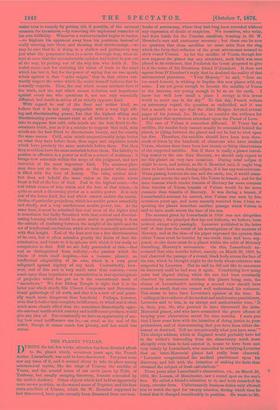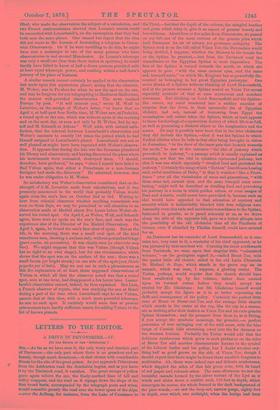THE PLANET VULCAN.
DURING the last few weeks, attention has been directed afresh to the planet which, seventeen years ago, the French doctor, Lescarbault, was said to have discovered. For years none saw any trace of it, and it seemed about to take its place among astronomical myths, like the rings of Uranus, the satellite of Venus, and the second moon of our earth (seen by Petit, of Toulouse, but usually escaping discovery, because concealed by the earth's shadow). Other objects which bad held an apparently more secure position, as the second moon of Neptune, and the four extra satellites of Uranus, which Sir W. Herschel supposed he had discovered, have quite recently been dismissed from our text-
books of astronomy, where they had long been recorded without any expression of doubt or suspicion. We ourselves, who write, had done battle for the Uranian satellites, trusting in Sir W. Herschel's care and customary accuracy ; but there can be now no question that these satellites no more exist than the ring which the forty-feet reflector of the great astronomer seemed to show round Uranus. As for the satellite of Venus, though few now suppose the planet has any attendant, such faith was once placed in its existence, that Frederick the Great proposed to give to it the name of his illustrious friend D'Alembert. It does not appear from D'Alembert's reply that he doubted the reality of that astronomical phantasm. "Your Majesty," he said, "does me too much honour, in wishing to baptise this new planet with my name. I am not great enough to become the satellite of Venus in the heavens, nor young enough to be so on the earth. I know too well how small a place I occupy in this lower world to covet one in the sky." To this day, French writers on astronomy regard the question as undecided, and it was but a month or so ago that the AVIA Moigno devoted several pages of his journal, Les Mondes, to consider the evidence for and against that mysterious attendant upon the Planet of Love.
The case of Vulcan is somewhat different. If Venus has a satellite, the smaller body cannot usually be concealed behind the planet, or (lying between the planet and us) be lost to view upon her disc. Therefore, the satellite should have been seen thou- sands of times by the hundreds of observers who have studied Venus, whereas there have been but twenty or thirty observations of the supposed satellite. But if there is really a planet travel- ling nearer to the sun than Mercury, we should only expect to see this planet on very, rare occasions. During total eclipse it might be seen, and indeed, as Sir J. Herschel said, it ought long since to have been seen during eclipse, if it has any real existence. When passing between the sun and the earth, too, it would some- times pass across the sun's face, like Venus in transit ; and for the same reasons which render transits of Mercury far more common than transits of Venus, transits of Vulcan would be far more common than transits of Mercury. It was during a transit, if Lescarbault's account be correct, that Vulcan was seen by him seventeen years ago, and news recently received from China re- specting the planet describes another passage which Vulcan is said to have made across the face of the sun.
The account given by Lescarbault in 1859 was not altogether satisfactory ; the principal flaw has not hitherto, we believe, been noticed, except very passingly. Leverrier published in the latter half of that year the result of his investigation of the motions of Mercury, and at the close of his paper expressed the opinion that either Venus must be heavier by one-tenth than had been sup- posed, or else there must be a planet within the orbit of Mercury disturbing Mercury's movements. On this, Lescarbault an- nounced that nine months before, namely, on March 26, 1859, he had observed the passage of a round, black body across the face of the sun, which he thought might be the body whose existence was suspected by Leverrier. But he said he did not like to announce its discovery until he had seen it again. Considering how many years had elapsed during which the sun had been constantly observed by astronomers without this planet being seen, the chance of Lescarbault's securing a second view should have seemed so small, that one cannot well understand his reticence. This seems to have been Leverrier's opinion at the time. In " calling at the residence of the modest and unobtrusive practitioner, Leverrier said to him, in an abrupt and authoritative tone, It is, then, you, Sir, who pretend to have discovered the intra- Mercurial planet, and who have committed the grave offence of keeping your observation secret for nine months. I warn you that I have come here with the intention of doing justice to your pretensions, and of demonstrating that you have been either dis- honest or deceived. Tell me unequivocally what you have seen." This abrupt address, which in England would probably have led to the visitor's descending from the observatory much more abruptly even than he had entered it, seems to have been met very calmly by Lescarbault, who succeeded in satisfying Leverrier that an intra-Mercurial planet had really been observed. "Leverrier congratulated the medical practitioner upon his discovery, and left with the intention of making the facts thus obtained the subject of fresh calculations."
Three years after Lescarbault's observation, viz., on March 20, 1862, Mr. Loomis, of Manchester, saw a round spot on the sun's face. He called a friend's attention to it, and both remarked its sharp, circular form. Unfortunately business duties only allowed him to watch the spot for twenty minutes, during which time he found that it changed considerably in position. He wrote to Mr. Hind, who made the observation the subject of a calculation, and two French mathematicians showed that Loonois's results could be reconciled with Lescarbault's, on the assumption that they had both seen the same planet. One cannot but regret that the idea did not occur to Mr. Loomis of forwarding a telegram to Green- wich Observatory. Or if he were unwilling to do this, he might have sent a messenger to one of the many persons who have observatories in and around Manchester. As Loomis's telescope was only a small one (less than three inches in aperture), he could hardly have failed to know of half-a-dozen persons provided with at least equal telescopic power, and residing within a half-hour's journey of his place of business.
A similar remark cannot certainly be applied to the observation last made upon this mysterious planet, seeing that the observer, M. Weber, was in Pe-chee-lee when he saw the spot on the sun, and may be forgiven for not telegraphing to Madras or Melbourne, the nearest well-provided observatories. The news reached Europe by post. "It will interest you," wrote M. Wolf to Leverrier, on the receipt of Weber's letter, "to know that on April 4, at half-past four Berlin time, M. Weber saw, at Peckeloh, a round spot on the sun, which was without spots in the morning and on the next day, as seen not only by M. Weber, but by my- self and M. Schmidt at Athens." Wolf adds, with natural satis- faction, that the interval between Lescarbault's observation and Weber's amounts to exactly 148 times the period which he had himself assigned to Lescarbault's planet. Lescarbault was not so well pleased as might have been expected with Weber's observa- tion. It appears that during the late war the Germans plundered his library and observatory, and having discovered the place where his instruments were concealed, destroyed them. "I should, therefore, have preferred," he says, "since I myself have failed to find Vulcan again, that either a Frenchman or a non-German foreigner had made the discovery." He admitted, however, that he was under obligation to M. Weber.
So satisfactory was Weber's observation considered, that on the strength of it M. Leverrier made fresh calculations, and it was presently announced to the world that probably Vulcan would again cross the sun's face on October 2nd or 3rd. Waiting to hear from colonial observers whether anything remarkable was seen on those days, we may be permitted to call attention to an observation made at Madrid about five hours before Weber ob- served his round spot. On April 3, as Weber, Wolf, and Schmidt agree, there were no spots on the sun's face, and such was the experience also of the Director of the Madrid Observatory. On April 5, again, he found the sun's face clear of spots. But on the 4th, in the morning, there was a small oval spot, of the kind sometimes seen, showing a nucleus only, without penumbral fringe (pur6 nude°, sin penumbra). It was clearly seen (se observaba muy bleu). We might suppose that this was Vulcan (though Vulcan has no right to an oval shape), but for one circumstance, which shows that the spot was on the surface of the sun ; there was a small facula (or bright streak) on one side of the spot (una fcicula pequaa por el ludo). May we not see in such a phenomenon as this the explanation of, at least, those supposed observations of Vulcan in which all that the observer noted was that a round spot, seen at one hour, had disappeared a few hours latex. Lescar- bault's observation cannot, indeed, be thus explained. But Liais, a French observer of repute, who was studying the sun at Brazil during a part of the time when Lescarbanit says he saw Vulcan, asserts that at that time, with a much more powerful telescope, be saw no such spot. It certainly would seem that at present astronomers have hardly sufficient reason for adding Vulcan to the list of known planets.



































 Previous page
Previous page